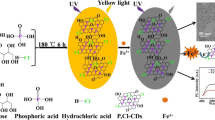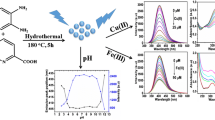Abstract
Phosphorus and nitrogen dually-doped carbon quantum dots (PN-CQDs) were prepared from sucrose, 85% phosphoric acid and 1,2-ethylenediamine as the sources for carbon, phosphorus and nitrogen, respectively. The PN-CQDs possess good water solubility and favorable biocompatibility. The excitation/emission peaks are at 365/451 nm, but bright blue, green, or red emissions are found depending on whether the excitation wavelengths of the laser are set to 408 nm, 488 nm, or 543 nm, respectively. Fluorescence is quenched by both vitamin B12 (VB12) and Co(II) by a combination of inner filter effect and static quenching. The PN-CQDs are shown to be useful nanoprobes for determination of VB12 and Co(II). Response to VB12 is linear in the range of 2.0–31 μM. The response to Co(II) is linear in two ranges, viz. from 1.7–12 μM and from 28 to 141 μM. The limit of detection of VB12 and Co(II) are 3.0 nM and 29.4 nM, respectively. The nanoprobe was successfully applied to the analyses of VB12 in drug samples and of Co(II) in spiked water samples, and it gave satisfactory results. The nanoprobe was also applied to the determination of VB12 and Co(II) in human hepatocarcinoma cells (type SMMC7721), human pulmonary epithelial cells (type BEAS-2B), human adenocarcinoma cells (type A549), and human pheochromocytoma cells (type PC12), respectively.

Schematic presentation of the quenching of the fluorescence of phosphorus and nitrogen dually-doped carbon quantum dots (PN-CQDs) by vitamin B12 (VB12) and Co(II).









Similar content being viewed by others
References
Kumar SS, Chouhan RS, Thakur MS (2010) Trends in analysis of vitamin B12. Anal Biochem 398:139–149
Samari F, Hemmateenejad B, Rezaei Z, Shamsipur M (2012) A novel approach for rapid determination of vitamin B12 in pharmaceutical preparations using BSA-modified gold nanoclusters. Anal Methods-UK 4:4155–4160
Wang J, Wei J, Su S, Qiu J (2015) Novel fluorescence resonance energy transfer optical sensors for vitamin B12 detection using thermally reduced carbon dots. New J Chem 39:501–507
Heudi O, Kilinc T, Fontannaz P, Marley E (2006) Determination of vitamin B12 in food products and in premixes by reversed-phase high performance liquid chromatography and immunoaffinity extraction. J Chromatogr A 1101:63–68
Zhang N, Wang W, Wang K, Ding Z, Wei Z (2008) Rapid determination of vitamin B12 by inductively coupled plasma mass spectrometry in multivitamin tablets. Spectrosc Lett 41:332–336
Baker SA, Miller-Ihli NJ (2000) Determination of cobalamins using capillary electrophoresis inductively coupled plasma mass spectrometry. Spectrochim Acta B 55:1823–1832
Jin G, Zhu Y, Jiang W, Xie B, Cheng B (1997) Spectrophotometric determination of cobalt(II) using the chromogenic reagent 4,4′-Diazobenzenediazoaminoazobenzene in a micellar surfactant medium. Analyst 122:263–265
Tomčik P, Banks CE, Davies TJ, Compton RG (2004) A self-catalytic carbon paste electrode for the detection of vitamin B12. Anal Chem 76:161–165
Gao Y, Guo F, Gokavi S, Chow A, Sheng Q, Guo M (2008) Quantification of water-soluble vitamins in milk-based infant formulae using biosensor-based assays. Food Chem 110:769–776
Gharehbaghi M, Shemirani F, Farahani MD (2009) Cold-induced aggregation microextraction based on ionic liquids and fiber optic-linear array detection spectrophotometry of cobalt in water samples. J Hazard Mater 165:1049–1055
Souza JMO, Tarley CRT (2009) Sorbent separation and enrichment method for cobalt ions determination by graphite furnace atomic absorption spectrometry in water and urine samples using multiwall carbon nanotubes. Int J Environ Sci Technol 89:489–502
Ussher SJ, Milne A, Landing WM, Attiq-ur-Rehman K, Séguret MJM, Holland T, Achterberg EP, Nabi A, Worsfold PJ (2009) Investigation of iron(III) reduction and trace metal interferences in the determination of dissolved iron in seawater using flow injection with luminol chemiluminescence detection. Anal Chim Acta 652:259–265
Wen X, Shi L, Wen G, Li Y, Dong C, Yang J, Shuang S (2016) Green and facile synthesis of nitrogen-doped carbon nanodots for multicolor cellular imaging and Co2+ sensing in living cells. Sensor Actuat B-Chem 235:179–187
Gong X, Li Z, Hu Q, Zhou R, Shuang S, Dong C (2017) N,S,P co-doped carbon nanodot fabricated from waste microorganism and its application for label-free recognition of manganese(VII) and L-ascorbic acid and AND logic gate operation. ACS Appl Mater Interfaces 9:38761–38772
Gong X, Zhang Q, Gao Y, Shuang S, Choi MMF, Dong C (2016) Phosphorus and nitrogen dual-doped hollow carbon dot as a nanocarrier for doxorubicin delivery and biological imaging. ACS Appl Mater Interfaces 8:11288–11297
Gupta A, Chaudhary A, Mehta P, Dwivedi C, Khan S, Verma NC, Nandi CK (2015) Nitrogen-doped, thiol-functionalized carbon dots for ultrasensitive hg(II) detection. Chem Commun 51:10750–10753
Liu X, Zhang N, Bing T, Shangguan D (2014) Carbon dots based dual-emission silica nanoparticles as a ratiometric nanosensor for Cu2+. Anal Chem 86:2289–2296
Gong X, Lu W, Paau MC, Hu Q, Wu X, Shuang S, Dong C, Choi MMF (2015) Facile synthesis of nitrogen-doped carbon dots for Fe3+ sensing and cellular imaging. Anal Chim Acta 861:74–84
Wang W, Peng J, Li F, Su B, Chen X, Chen X (2019) Phosphorus and chlorine co-doped carbon dots with strong photoluminescence as a fluorescent probe for ferric ions. Microchim Acta 186:32
Lin L, Wang Y, Xiao Y, Liu W (2019) Hydrothermal synthesis of carbon dots codoped with nitrogen and phosphorus as a turn-on fluorescent probe for cadmium(II). Microchim Acta 186:147
Sun X, Wu L, Shen J, Cao X, Wen C, Liu B, Wang H (2016) Highly selective and sensitive sensing for Al3+ and F− based on green photoluminescent carbon dots. RSC Adv 6:97346–97351
Li P, Sun X, Shen J, Liu B (2016) A novel photoluminescence sensing system sensitive for and selective to bromate anions based on carbon dots. RSC Adv 6:61891–61896
Gong X, Lu W, Liu Y, Li Z, Shuang S, Dong C, Choi MMF (2015) Low temperature synthesis of phosphorous and nitrogen co-doped yellow fluorescent carbon dots for sensing and bioimaging. J Mater Chem B 3:6813–6819
Shen P, Xia Y (2014) Synthesis-modification integration: one-step fabrication of boronic acid functionalized carbon dots for fluorescent blood sugar sensing. Anal Chem 86:5323–5329
Barati A, Shamsipur M, Abdollahi H (2015) Hemoglobin detection using carbon dots as a fluorescence probe. Biosens Bioelectron 71:470–475
Liu Y, Gong X, Dong W, Zhou R, Shuang S, Dong C (2018) Nitrogen and phosphorus dual-doped carbon dots as a label-free sensor for curcumin determination in real sample and cellular imaging. Talanta 183:61–69
Wei J, Yang Y, Dong J, Wang S, Li P (2019) Fluorometric determination of pesticides and organophosphates using nanoceria as a phosphatase mimic and an inner filter effect on carbon nanodots. Microchim Acta 186:66
Hu Q, Li T, Gao L, Gong X, Rao S, Fang W, Gu R, Yang Z (2018) Ultrafast and energy-saving synthesis of nitrogen and chlorine co-doped carbon nanodots via neutralization heat for selective detection of Cr(VI) in aqueous phase. Sensors 18:3416
Xu Z, Yang L, Fan X, Jin J, Mei J, Peng W, Jiang F, Xiao Q, Liu Y (2014) Low temperature synthesis of highly stable phosphate functionalized two color carbon nanodots and their application in cell imaging. Carbon 66:351–360
Gong X, Hu Q, Paau MC, Zhang Y, Shuang S, Dong C, Choi MMF (2014) Red-green-blue fluorescent hollow carbon nanoparticles isolated from chromatographic fractions for cellular imaging. Nanoscale 6:8162–8170
Gong X, Liu Y, Yang Z, Shuang S, Zhang Z, Dong C (2017) An "on-off-on" fluorescent nanoprobe for recognition of chromium(VI) and ascorbic acid based on phosphorus/nitrogen dual-doped carbon quantum dot. Anal Chim Acta 968:85–96
Moreno P, Salvado V (2000) Determination of eight water- and fat-soluble vitamins in multi-vitamin pharmaceutical formulations by high-performance liquid chromatography. Chromatogr A 870:207–215
Vinas P, Campillo N, Lopez-Garcia I, Hernandez-Cordoba M (1996) Identification of vitamin B12 analogues by Liquid Chromatography with Electrothermal Atomic Absorption Detection. Chromatographia 42:566–557
Zu F, Yan F, Bai Z, Xu J, Wang Y, Huang Y, Zhou X (2019) The quenching of the fluorescence of carbon dots: a review on mechanisms and applications. Microchim Acta 184:1899–1914
Bai Z, Yan F, Xu J, Zhang J, Wei J, Luo Y, Chen L (2018) Dual-channel fluorescence detection of mercuric (II) and glutathione by down- and up-conversion fluorescence carbon dots. Spectrochim Acta A 205:29–39
Acknowledgements
This work was supported by the National Science Foundation of China (No. 21705101 and 21575084), China Postdoctoral Science Foundation (No. 2018 M642969) and the Hundred Talent Programme of Shanxi Province, all of which are gratefully acknowledged. We also acknowledge Dr. Juanjuan Wang from the Scientific Instrument Center at Shanxi University for her help with LSCM measurements.
Author information
Authors and Affiliations
Corresponding authors
Ethics declarations
The author(s) declare that they have no competing interests.
Additional information
Publisher’s note
Springer Nature remains neutral with regard to jurisdictional claims in published maps and institutional affiliations.
Electronic supplementary material
ESM 1
(DOCX 4771 kb)
Rights and permissions
About this article
Cite this article
Zhang, L., Wang, H., Hu, Q. et al. Carbon quantum dots doped with phosphorus and nitrogen are a viable fluorescent nanoprobe for determination and cellular imaging of vitamin B12 and cobalt(II). Microchim Acta 186, 506 (2019). https://doi.org/10.1007/s00604-019-3617-0
Received:
Accepted:
Published:
DOI: https://doi.org/10.1007/s00604-019-3617-0




